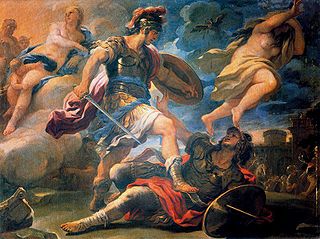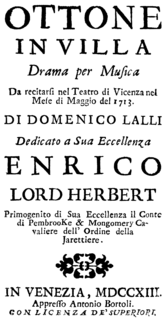Related Research Articles

Turnus was the legendary King of the Rutuli in Roman history, and the chief antagonist of the hero Aeneas in Virgil's Aeneid.

Giovanni Bononcini was an Italian Baroque composer, cellist, singer and teacher, one of a family of string players and composers.

In Virgil's Aeneid, Camilla of the Volsci is the daughter of King Metabus and Casmilla. Driven from his throne, Metabus is chased into the wilderness by armed Volsci, his infant daughter in his hands. The river Amasenus blocked his path, and, fearing for the child's welfare, Metabus bound her to a spear. He promised Diana that Camilla would be her servant, a warrior virgin. He then safely threw her to the other side, and swam across to retrieve her. The baby Camilla was suckled by a mare, and once her "first firm steps had [been] taken, the small palms were armed with a keen javelin; her sire a bow and quiver from her shoulder slung." She was raised in her childhood to be a huntress and kept the companionship of her father and the shepherds in the hills and woods.

Siroe, re di Persia, is an opera seria in three acts by George Frideric Handel. It was his 12th opera for the Royal Academy of Music and was written for the sopranos Francesca Cuzzoni and Faustina Bordoni. The opera uses an Italian-language libretto by Nicola Francesco Haym, after Metastasio's Siroe. Like many of Metastasio's libretti, it was also set by Handel's contemporaries, e.g. by Leonardo Vinci, Antonio Vivaldi and Johann Adolph Hasse. Pasquale Errichelli's setting of the libretto premiered in the year of Handel's death.

Ottone in villa is an opera in three acts by Antonio Vivaldi to an Italian libretto by Domenico Lalli. It was Vivaldi's first opera and premiered on 17 May 1713 at the Teatro delle Grazie in Vicenza. Lalli's pastoral drama is set in ancient Rome and was a condensed adaptation of Francesco Maria Piccioli's satirical libretto for Carlo Pallavicino's opera Messalina (1679). However, Lalli changed several of the characters in Piccioli's libretto. Messalina became an invented character, Cleonilla. Emperor Claudius became another Roman emperor, Otho (Ottone), who had already appeared as a protagonist in Monteverdi's L'incoronazione di Poppea (1642) and in Handel's Agrippina (1709).

Nicola Francesco Haym was an Italian opera librettist, composer, theatre manager and performer, literary editor and numismatist. He is best remembered for adapting texts into libretti for the London operas of George Frideric Handel and Giovanni Bononcini. Libretti that he provided for Handel included those for Giulio Cesare, Ottone, Flavio, Tamerlano, Rodelinda, and several others; for Bononcini, he produced two, Calfurnia and Astianatte.

Anastasia Robinson, later known as Anastasia, Countess of Peterborough, was an English soprano, later contralto, of the Baroque era. She is best remembered for her association with the composer George Frideric Handel, in whose operas she sang.

The Avenger is a 1962 film directed by Giorgio Venturini.
Silvio Stampiglia was an Italian poet, librettist, and founder member of the Accademia dell'Arcadia under the pen name of Palemone Licurio.
Claire Meghnagi is an Israeli operatic soprano of Italian origin.

Maria Caterina Negri was an Italian contralto who created numerous roles in 18th-century operas, including many by George Frideric Handel. She primarily portrayed male characters en travesti or female warriors such as Bradamante. Negri was born in Bologna and made her debut there at the age of 15. Her last known performance was in 1744. The date and place of her death are unknown. In its prime, her voice was known for its agility and wide vocal range.
Arsinoe, Queen of Cyprus by Thomas Clayton was the first Italian-style opera to be staged in England. It premiered at the Theatre Royal, Drury Lane on 16 January 1705. There were various historical women named Arsinoe, but from the mid seventeenth-century the name became popular for fictional characters who, like the title-role of this opera, bore no relation to any of them.

Thomyris, Queen of Scythia was a pasticcio opera based on a libretto by Peter Anthony Motteux. It was produced by John James Heidegger at the Theatre Royal, Drury Lane in April 1707. Motteux’s prologue directly referenced Anne, Queen of Great Britain, under whose reign female stage protagonists were very popular.

Almahide is a pasticcio opera arranged by John Jacob Heidegger. Musically the work was based on Ariosti’s Amor tra nemici (1708), but most of the arias were replaced by the work of other composers, including six arias from Giovanni Bononcini‘s Turno Aricino.

Hydaspes is an opera by Francesco Mancini with a libretto by Giovanni Pietro Candi. It was first performed at the King's Theater in the Haymarket, London, on 23 March 1710. It was the second opera in England to be sung entirely in Italian, after Almahide, and was an early London success for the famous castrato Nicolò Grimaldi in the title role.

Pyrrhus and Demetrius was a 1708 adaptation for the London stage of the 1694 opera Il Pirro e Demetrio by Alessandro Scarlatti with a libretto by Adriano Morselli, first performed at the it:Teatro San Bartolomeo.

Rosamond is an opera in three acts by Thomas Clayton with a libretto by Joseph Addison. It was first performed on 4 March 1707 at Drury Lane.

Siface re di Numidia is a libretto in three acts by Pietro Metastasio. It is a reworking of La forza della virtù by de:Domenico David and was Metastasio’s first work as a librettist. it was first performed with a setting to music by Francesco Feo on 13 May 1723 at the Teatro San Bartolomeo, Naples.
Mary Lindsey known as Mrs Lindsey was a British singer. She specialised in comedic roles particularly opposite Richard Leveridge. She appeared in the first all-sung operas in the UK in English.
Santa Stella was an Italian soprano. She was also known as Santa Stella Scarabelli and after her marriage to Antonio Lotti on 12 February 1714 as Santa Lotti or La Santini.
References
- ↑ James Anderson Winn (2014-06-03). Queen Anne: Patroness of Arts. Oxford University Press. pp. 707–. ISBN 978-0-19-937220-1.
- 1 2 3 Shirley Strum Kenny (1984). British Theatre and the Other Arts, 1660-1800. Associated University Presses. ISBN 978-0-918016-65-2.
- 1 2 George E. Dorris (2014-07-24). Paolo Rolli and the Italian Circle in London, 1715–1744. De Gruyter. pp. 301–. ISBN 978-3-11-156078-6.
- 1 2 3 4 Kidson, Frank (1922). The Beggar's Opera, its Predecessors and Successors. Cambridge University Press. p. 20. GGKEY:H45DGE9GARC.
- 1 2 3 Lindgren, Lowell. "Trionfo di Camilla, regina de' Volsci, Il ('The Triumph of Camilla, Queen of the Volscians')". oxfordmusiconline.com. Grove Music Online. doi:10.1093/gmo/9781561592630.article.O002344 . Retrieved 15 December 2019.CS1 maint: discouraged parameter (link)
- 1 2 3 4 5 6 7 "Il Trionfo di Camilla". operabaroque.com. Opéra Baroque. Retrieved 15 December 2019.CS1 maint: discouraged parameter (link)
- 1 2 3 4 "Trionfo di Camilla regina de' Volsci, Il". opera manager.com. Opera Manager. Retrieved 15 December 2019.CS1 maint: discouraged parameter (link)
- ↑ Peter Gordon (2007-05-07). Musical Visitors to Britain. Routledge. p. 40. ISBN 978-1-135-78360-0.
- 1 2 Philip H. Highfill; Kalman A. Burnim; Edward A. Langhans (1973). A Biographical Dictionary of Actors, Actresses, Musicians, Dancers, Managers & Other Stage Personnel in London, 1660-1800: Tibbett to M. West. SIU Press. ISBN 978-0-8093-1802-5.
- ↑ "Libretti". corago.unibo.it. University of Bologna. Retrieved 15 December 2019.CS1 maint: discouraged parameter (link)
- ↑ Lawrence, W.J. (January 1921). "The Early Years of the First English Opera House". The Musical Quarterly. 7 (1): 104–117. doi:10.1093/mq/VII.1.104. JSTOR 738021.
- ↑ "Opere". corago.unibo.it. University of Bologna. Retrieved 15 December 2019.CS1 maint: discouraged parameter (link)